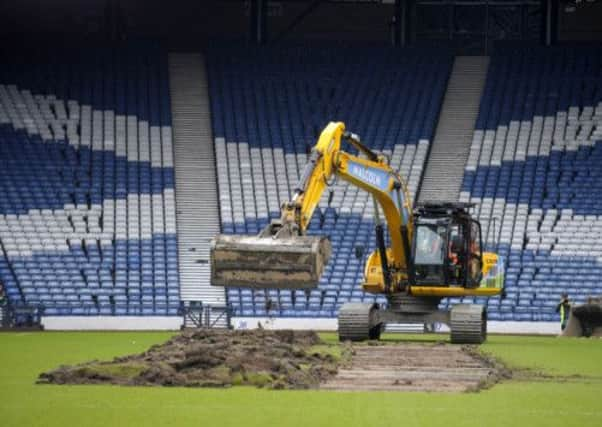Glasgow 2014: Commonwealth work on Hampden begins


The venue is being temporarily transformed to host the stars of track and field as they compete for gold in Glasgow next summer.
The playing surface of the stadium is being raised by around 6ft on a grid of steel stilts to create the width and length required for an International Association of Athletics Federations-approved athletics track.
Advertisement
Hide AdAdvertisement
Hide AdDuring the Games, the stadium will seat 44,000, returning to its 52,000 capacity at the end of the event.
David Grevemberg, chief executive of Glasgow 2014, said: “Ever since the time of Eric Liddell, Hampden has hosted athletics events, and to be able to come back from that standpoint and that heritage with a very pioneering, innovative design that we are able to implement on a sustainable basis, it’s true to form.
“We are doing something very special here and we take that very much to heart. At the same time, we recognise that this is sacred ground and we need to reinstate it back to the original form. It’s daring, and we’ve tried to be daring from the start with this Commonwealth Games.”
Hampden Park managing director Peter Dallas said: “After six years of detailed planning, today is another key date in our calendar. Everyone at Hampden is looking forward to assisting with the delivery of the Games, which will add another chapter to Hampden’s long and proud history.”
The stadium is expected to be reconfigured by mid-May and is due to host the Scottish Schools Athletics Championships in June.
Glasgow will take the Commonwealth Games to a higher level – with stilts
HAMPDEN Park has stood on Mount Florida for 110 years. This is ground that has been trodden by football fans – 100,000 at a time in days of old – concert-goers, American footballers and any number of corporate day-trippers. It is ground that was described yesterday as “sacred” by a man who had just commanded a JCB driver to begin tearing at the turf.
The National Stadium is now in the hands of David Grevemberg, a native of New Orleans who is chief executive of the Glasgow 2014 Commonwealth Games organising committee.
Advertisement
Hide AdAdvertisement
Hide AdHe is charged with making sure that one of the world’s most famous football grounds becomes synonymous with great feats in track and field next summer, and then returns to its original form.
And these new tenants are not simply lifting grass. That would be far too 20th century. Modern, multi-million-pound, multi-sport Games are about aiming higher than anybody has gone before, and this sacred ground will be considerably higher come next May.
This is not a metaphor. The surface will be 190 centimetres higher than it is today – a shelf of concrete and asphalt, rubber and grass, supported on hundreds of steel stilts placed 2.5 metres apart.
This is the raised stage on which Jessica Ennis-Hill and perhaps Usain Bolt will do their thing next July and August, and there is no risk of them falling off because the whole stadium is moving up in the world.
The eight rows of seats nearest to ground level will be swallowed up by the track-and-field surface.
A major Games has never taken place on stilts before, but the Glasgow 2014 team assured us yesterday that all possible risks had been factored into their decision to transform Hampden in a way that will make the world take note.
“The Olympic equestrian events used the same system, but that was out in an open park,” said Ian McKenzie, head of venue development at Glasgow 2014, referring to last year’s Olympic event in Greenwich Park. “To our knowledge it’s never been done in a stadium, and certainly for athletics, never on this scale.”
Hampden is unusual for a modern football stadium because it is shaped as a bowl, not a rectangle. That is why they chose to host athletics here. However, it was not big enough, hence the attempt to mirror through engineering the level of innovation that Alfredo di Stéfano and Zinedine Zidane have brought to the south of Glasgow in the past.
Advertisement
Hide AdAdvertisement
Hide Ad“It’s pretty exciting and innovative, and I really do believe that we’ll see more of this, because the world has got lots of big stadia but not lots of athletics venues with big capacities,” Mr McKenzie added, confirming that the conversion of Hampden will cost £14 million, compared with the minimum £120m it would cost to build a venue from scratch.
As Malcolm Construction’s finest disfigured the centre circle, the Glasgow 2014 chief executive took a deep breath when asked what he wanted to say to the football fans who may have mixed feelings about the removal of this season’s Scottish Cup semi-finals to Celtic Park and Ibrox, as well as the final itself to Celtic Park. “I would say thank you,” said Mr Grevemberg.